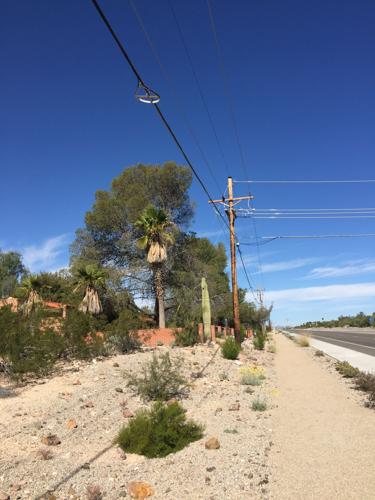Several readers responded to the question a couple weeks ago about when to pick olives with a follow up request for help with how to cure the olives. For an in-depth look at how to cure olives, I recommend this publication by the University of California: anrcatalog.ucanr.edu/pdf/8267.pdf
Question: I found a patch of Aleppo pine that is dying on the west side of La Canada. The road was recently widened (3 years ago) and this whole group fronts close to the road. Could the die-off be due to road widening?
Answer: Yes, the trees could be suffering from the road widening. Construction would likely damage the roots on that side of the tree and typically damage such as this shows up above ground a few years later. It would be difficult to protect such large trees in a road-widening because their roots likely extend two to three times the width of the crown. In a different construction situation the property owner could ask for a protective zone to be fenced off around the tree to help more of the root system to survive. Typically when we see trees that have been attacked by pine engraver beetles, the color of the needles ranges from straw to reddish colors.
Question: I have a palm tree the city wants me to trim. I don’t want to spend the money to have someone else do it. I don’t want to climb a 20-foot ladder with a chainsaw. And I like the way this tree looks. Can you help me by saying something about how this form is considered by many people to be attractive and is a common landscape practice?
Answer: It is a common practice to leave a full skirt on palm trees and you can find others in the city just like yours. Most palm trees with a full skirt are a bit taller and as long as the bottom 10 feet of the tree is bare and the dead fronds are away from anything that might catch fire, everything is deemed okay. Some people find the natural form of these trees with a full skirt to be attractive and others like to see them well pruned. Unfortunately for you, the city requires the latter when the skirt hangs low like yours does. The hazards of palm skirts and the risks are mostly fire and having it fall on someone and crush them.
Question: I’ve never seen a bug like this one found in my garage. It had eyes and would move quickly when I put my finger in front of it.
Answer: This is a solpugid. It is a member of the arachnid class in the phylum of arthropods and related to spiders and scorpions but distinct enough to warrant their own order. Their habitat is the desert and they are predators of other arthropods and have a reputation for being fast; their top speed is reportedly around 10mph. They have no venom, are harmless to humans, and do a good bit of pest management for us while we sleep. All things considered, they are good to have around.






